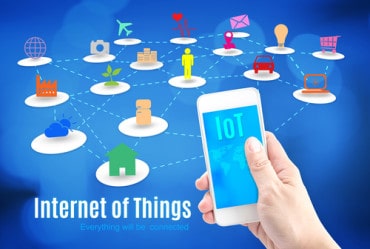
A high-speed backbone can enable new technology and automated data collection across the entire supply chain.
When consumers think about the benefits of 5G networks, they typically focus on faster speeds and more reliable connections for smartphones. But 5G networks could also enable the food industry to share greater insight into food’s journey from farm to fork while simultaneously lessening food safety concerns.
See also: IBM and Food Safety: Building Around the Blockchain
5G networks have the potential to enable dynamic, end-to-end food traceability – thanks to an ability to connect to many low-power devices, like embedded Internet of Things sensors at the same time. As a result, the food supply chain will be able to further modernize its practices and processes, becoming super-interconnected and better equipped to leverage technologies like blockchain and AI. That will increase accountability of food businesses in the event of foodborne illness outbreaks, help organizations better mitigate food safety risk and streamline costs for companies and, in turn, consumers. But with all of this promise, how do we get there?
Current landscape and challenges
First, we must understand how food traceability practices are evolving in today’s landscape. In the food industry, traceability refers to the systemic ability to track the forward movement of food products and ingredients through the supply chain and trace the history of its movement back to the source. Traceability has historically been used as a business to business exchange of information that is largely focused on enabling rapid and complete product recalls. In today’s context, both the food industry and consumers are seeing traceability as a way of increasing transparency, accountability and trust across the supply chain.
Food traceability: Use cases and framework
Food traceability initiatives and technologies are mainly trying to address six primary use cases: food fraud, food safety and recalls, regulatory compliance, social issues, sustainability, and consumer information. For example, food fraud is a problem that all areas of the food industry grapples with because it touches every part of the supply chain. This happens when a food or beverage product is sold in a way that is deliberately misleading to consumers for financial gain.
One potential solution for combatting the informational side of food fraud is through blockchain. It can create a more straightforward trail of data that can be used to document traceability information and therefore investigate food fraud.
Blockchain has unique capabilities and features that are especially attractive for food traceability. These include creating a distributed ledger that houses time-stamped and unchangeable records of transformation, transport, and consumption. In this way, all supply chain players have access and more equal governance on traceability data. Historically, obtaining this information has been a lengthier process that would only occur in the event of a food safety outbreak investigation. But by digitizing records and making them easily accessible throughout the entire food supply chain, blockchain could both alleviate and streamline this process.
As promising as technologies like blockchain are for the food industry, without standards and common best practices throughout the supply chain, their potential will remain elusive. As industry adoption of technologies like blockchain becomes more widespread, it’s critical that organizations design food traceability architectures that are responsive against the six main use cases and operational goals. To do this, the system framework must incorporate the concepts of critical tracking events (CTEs) and key data elements (KDEs).
New technologies need new system frameworksI
CTEs refer to events that must be recorded to allow for effective traceability of products in the supply chain. KDEs are data inputs that allow a user to trace a product or its ingredients. Together, KDEs can track products through all relevant CTEs to provide insight into the operational goal of the traceability system. Through leveraging this CTE/KDE framework, the food industry can build traceability systems that are designed to be technology agnostic based on existing standards that maximize the potential of emerging digital technologies.
As 5G networks become the industry standard, it’s critical that common data standards are set and adopted industry-wide to ensure the long-term success of emerging technologies like IoT, blockchain and AI. The CTE/KDE framework is a good example of setting this standard to better enable technology providers to develop solutions that work across the supply chain – and enable food companies to achieve end-to-end traceability.
5G technology: What makes it different
With the advent of 5G, the opportunities for disruption and innovation are significant for the food industry. A big reason will be due to how it will enable adoption of other new digital technologies industry-wide. 5G networks provide users and companies more bandwidth than ever and enable low latency data transfers for real-time information distribution. Ultimately, this provides users and devices with more immediate and reliable communications compared to 4G or even WiFi. 5G will change the nature of internet connectivity, from limited quantity and quality outside WiFi connections to universal, fast speed, gigabit connections everywhere.
Another main benefit of 5G is its low power needs compared to 4G or 3G technology, meaning it takes less power to communicate to the network. One of the biggest advantages it brings is a greater networking capability, so it has more capacity to handle multiple inputs and devices all at once. For example, a smart home has temperature sensors and activity monitors to maximize efficiency. Similarly, a smart food processing facility takes this to a broader scale with hundreds of devices that need to simultaneously connect, interact and share data in real time. 5G makes this a reality with its greater flexibility to connect to the internet.
In short, 5G will transform internet connectivity into a much more integrated, seamless ecosystem and is useable for large scale industrial applications, including logistics and the food supply chain. As 5G is rolled out nationwide, it will allow food traceability to be modernized in ways that have remained difficult up until this point.
Foodborne illnesses and 5GI
Through the increased network capabilities 5G brings, food companies will have the ability to network many different IoT-enabled devices at the same time. This means the promises of IoT sensors and devices will extend far beyond the production facility, making monitoring food products from farm to fork that much easier.
Food supply chains are typically difficult to monitor in a cost-effective way. Consumers expect a safe, low-cost product, easily accessible at every time of the year. These factors, along with the speed needed to bring food to consumers, leave little room for technology investment for traceability systems.
And food products sometimes go from the field to a consumer’s plate in less than a week, which can make traceability efforts even more complex – and crucial. Take the recent E. coli outbreak linked to romaine lettuce earlier this year. The outbreak began in October 2018; cases were reported in 16 states and persisted through early December. The Food & Drug Administration (FDA), Center for Disease Control & Prevention (CDC) and state partners were able to pinpoint that romaine lettuce from the central coastal growing regions of northern and central California were likely the source of the outbreak.
After identifying the general geographical source, they were able to notify consumers to avoid purchasing or consuming lettuce grown in those regions. In the end, the traceback investigation revealed the strain stemmed from an agricultural reservoir on a farm in Santa Barbara County. Unfortunately, 62 people were infected, and 25 people were hospitalized during the time of the investigation. Thankfully, there were no deaths reported.
But foodborne illness outbreaks like this can have dire consequences. It’s a prime example of how complex food monitoring can be, and the lengthy process that traceback investigations must still undergo. How does 5G play into all of this? The technological advancement will be instrumental in enabling industry-wide adoption of technologies like blockchain. While blockchain is not a silver bullet solution for traceability, its widespread adoption would significantly help with the speed and accuracy of pinpointing the source of foodborne illness outbreaks.
The future of food traceability
Food often originates from rural, low-infrastructure environments. Access to the latest and greatest technology has been stymied in these settings due to network limitations. 5G networks are being rolled out to rural locations in addition to more urban environments, removing the historical barriers of implementing technologies like IoT devices across the entire supply chain. As food producers are able to use more interconnected IoT devices, their ability to automate and verify supply chain data including temperature, humidity, geolocators , and even molecular detection will improve greatly. These added capabilities add another level of assurance to food safety. Perhaps most importantly, they will considerably aid traceback investigation efforts, helping to quickly pinpoint the source of foodborne illness outbreaks.
5G will enable dynamic interaction between manufacturing, harvesting, food production equipment and even the products themselves. It has the potential to change the food system as we know it. 5G is essentially the backbone to making new technologies a reality. With its potential to enable greater, more automated data collection across the entire supply chain, 5G will help usher in a new era of our food system – and era built on transparency, sustainability, and safety.




























